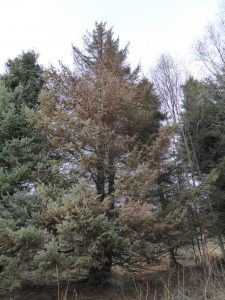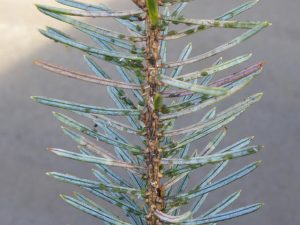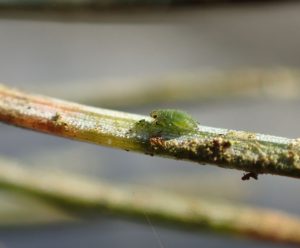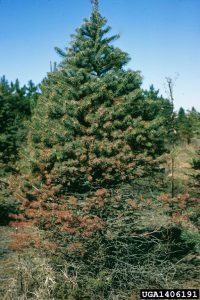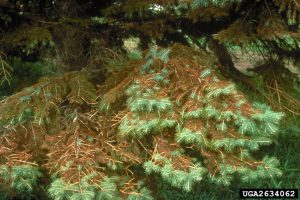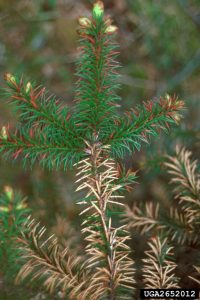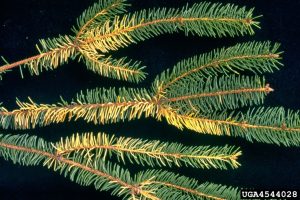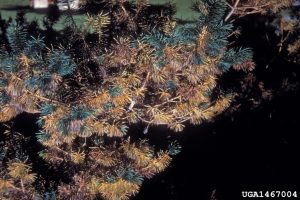Hosts
In Alaska, spruce aphid infests spruce species, especially Sitka spruce. Neither tree size nor age influences whether a tree will be infested with spruce aphids; however, tree location is important. In Alaska, spruce in coastal areas and trees stressed by urban and landscape situations are particularly susceptible to damage caused by spruce aphid. Spruce aphids can be found at higher elevations in Alaska if other environmental factors are favorable.
Known distribution
Spruce aphids have been present in Southeast Alaska for decades. A few notable populations have also been detected throughout the years along Prince William Sound, the south side of the Kenai Peninsula, and the Kodiak Archipelago. In 2015, spruce aphids and spruce aphid damage were detected on the south side of Kachemak Bay and in Homer, representing the first record of these aphids on the western side of the Kenai Peninsula. In 2016, damage continued in these areas and was also noted on several islands of the Kodiak Archipelago.
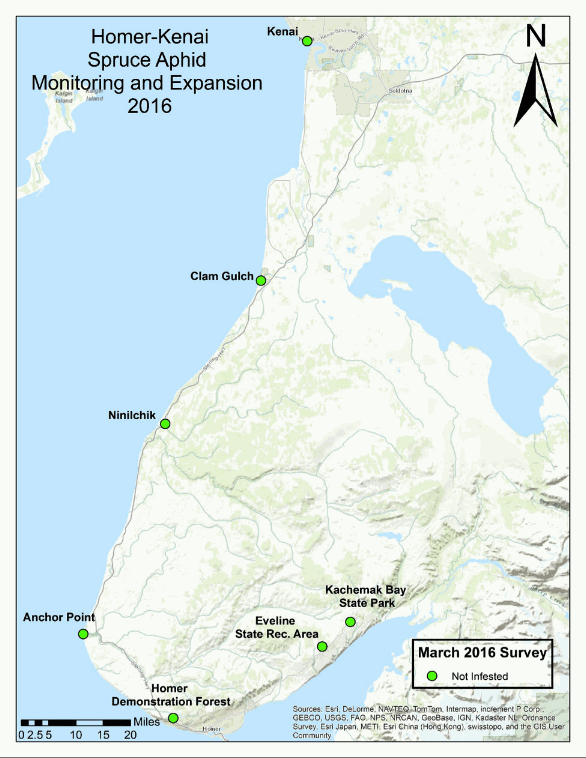
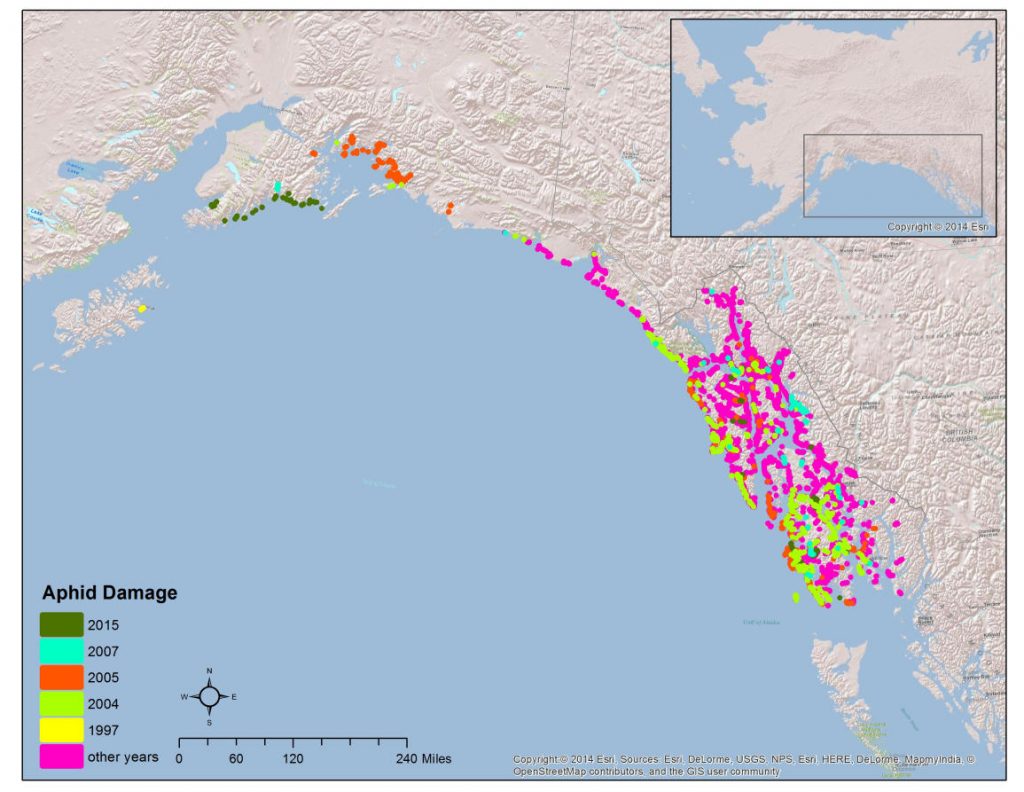
Weather factors affecting populations
Spruce aphids are a climate-limited pest. As shown above, spruce aphid distribution in Alaska has previously been limited to milder areas of the state. Colder temperatures can play a couple of roles in limiting aphid populations. Aphids become inactive at or below approximately 42 °F (Powell and Parry 1976); prolonged periods of cold can kill aphids outright or result in starvation. Many aphids die at temperatures at or below approximately 19 °F. If aphids are actively feeding on needles, most aphids will die at temperatures at or below 14 °F because of the formation of ice crystals in the tree sap that is transferred to the aphid during feeding. If aphids are not actively feeding and are detached from the needles they may survive to lower temperatures. When temperatures remain relatively low for prolonged periods of time but above the lethal temperatures, spruce aphid mortality may still occur and can negatively impact aphid population levels.
Spruce aphid outbreaks tend to follow mild winters where temperatures remain above freezing. Field observations suggest that two or more successive warmer winters may be needed for populations to outbreak. Other factors also contribute to spruce aphid population changes such as density of aphids on the host plant and the presence of natural enemies.
How to ID an infestation
Another method for monitoring for spruce aphid is referred to as the “beat sheet” method. Traditionally, this method uses a large piece of fabric stretched over a sturdy frame which is held beneath vegetation. A pole or stick is used to tap on the branches to dislodge insects which fall onto the fabric and can then be collected, counted, observed, etc. This method may be easier on larger trees with higher branches. If the goal is simply to determine if the pest is present, a simple set up using a clipboard or other sturdy surface with a piece of plain copy paper can substitute for the traditional gear. Simply hold the paper beneath the branches and tap them with a pole or stick to dislodge anything onto the paper where it can be further examined.
This short video shows how to use a beat sheet. While it is geared toward trees in orchard production, the principles of use and equipment are the same.
Whether visually inspecting individual branches or trying the beat sheet method, monitor trees weekly through the spring. Check trees again in the fall for autumn populations.
What’s NOT spruce aphid
There are several diseases that can cause needles to change color and drop from trees. Needlecast may be caused by one of a handful of fungi that infect needles or twigs. Once the infection occurs it can take a year or so before the symptoms are noticeable. Needlecast damage is very similar to spruce aphid damage in that the older needles are affected while the current year’s growth remains green. It can be difficult to distinguish needlecast from spruce aphid damage. The presence of aphids can help differentiate the damage as well as the presence of needlecast fruiting bodies on the needles.
Many aphids may be observed on spruce trees; however, not all aphids will cause the same damage as spruce aphid. As their name implies, giant conifer aphids are much larger than spruce aphids and can be 2-5 mm long. Giant conifer aphids are also brown in color versus the bright green of spruce aphids. Additionally giant conifer aphids are rarely found on needles as they feed on branches and stems.
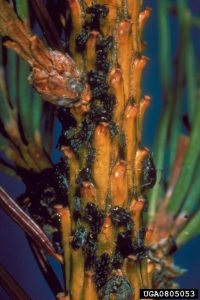
Woolly adelgids are small insects that are very closely related to aphids. They have similar feeding styles and can cause similar damage to needles when populations are high. Woolly adelgids can be distinguished from spruce aphids because the insects produce a waxy substance to cover their bodies and protect them while they are feeding. The waxy secretions look like woolly tufts along the needles of the trees. Spruce aphids do not produce the woolly tufts.
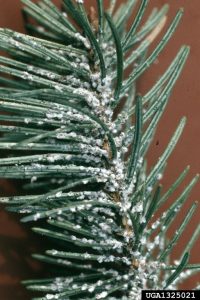
Other conditions
Other conditions can result in needle discoloration and early needle drop. Drought, root damage, and chemical damage can all lead to discoloration and drop in spruce trees. There can also be some bit of natural needle drop within spruce trees. Over time, a tree may not need all of the needles it has ever produced in its life and will shed those that are not as efficient or productive. The presence of aphids and the history of the tree are the best ways to distinguish between these conditions and spruce aphid damage.
It is also important to note that there is always the possibility for more than one of these pests or conditions to be occurring simultaneously. Take the time to check the trees and note observations of health before determining cause.

